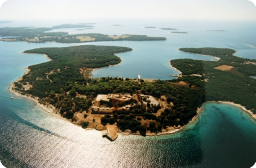

Brioni National Park
Along the western Istrian coast, there are several island groups. The most interesting, largest and most indented of these is the Brijuni island group, which comprises 14 islands and covers an area of 7.42 km2.
The present-day boundaries of the National Park were set in 1999 and comprise the land, the surrounding sea and the seabed. The park covers an area of 33.9 km2. The length of the coastline of all the islands is 46.8 km. The most indented islands are Veliki Brijun (25.9 km) and Mali Brijun (8.3 km). The shores are mostly low and rocky but easily accessible due to the horizontal stratification of the rocks, and in some bays pebbles and sand can be found.
The National Park of Brioni includes the following islands: Veliki Brion, Mali Brijun, Sveti Marko, Gaz, Okrugljak, Supin, Supinić, Galija, Grunj, Vanga (Krasnica), Pusti (Madona), Vrsar, Sveti Jerolim and Kozada. Geologically and geomorphologically, the Brijuni islands are the continuation of western Istria or so-called "Red Istria". Since the depth of the Fažana Channel is just 12 metres, the Brijuni islands were until some 10,000 years ago an integral part of Istria.
The islands are made of horizontal or slightly inclined layers of limestone from the Cretaceous period. In places, there are layers of carbonated brown or red soil. The stone that belongs to this formation is white in colour, easily breakable, of marble structure and abundant in clay and flint. Therefore it is very solid and is an excellent building material. Roman builders appreciated the qualities of this stone and it was used to build many towns along the Adriatic.
Climatically, the Brioni islands have a northern Mediterranean type of climate and share the features of the climate of the western Istrian coast with a relatively high level of atmospheric humidity (76%). The average yearly temperature is 13.9 C, average precipitation 817 mm, and the average number of hours of sunshine is 2,350 hours per year.
The main characteristic of the Brioni archipelago is its extraordinary biological diversity. This is a result of its geographical location, geology, geomorphology, diversity of habitats and isolation.
The natural biological diversity has been enriched by men’s traditional husbandry. Veliki Brion is the largest island of the archipelago and has been cultivated into a harmonious landscape of meadows and parks. Besides the remnants of the island’s rich architectural heritage, the vegetation types typical of the western Istrian climate have also been preserved. It is important to underline that the sea forms 80% of the protected area of the National Park and contains almost all the elements of the Adriatic marine ecosystem.
Source: http://www.brijuni.hr/
Reception is in the Hotel Neptune. For information, phone: +385 52 525 807.
Video
Current news
 Macrocruise charter agency
Additional discount on the boat rental price of betw
Macrocruise charter agency
Additional discount on the boat rental price of betw





























